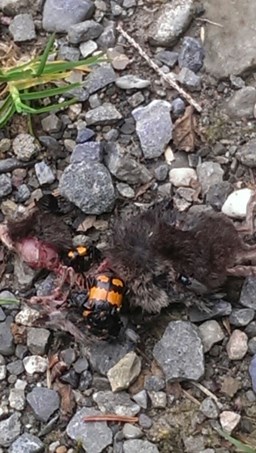Topic 2 Introductory Ideas

Sexton Beetles
How can you capture students' interest? Ecology and ecosystems are fundamental to the course and student understanding of how humans impact ecosystems but I've often found that students struggle with these concepts. It can be a challenge to engage students and I think the concepts need to be covered early in the course which makes it doubly tricky.
One of the tricks I've found is to have several small introductory activities and ones that can be observed over time but that are not assessed summatively. Students will come early to class to check on their projects or will come and talk to you about things they've noticed.
On this page I have gathered together some of these simple ideas with links to more resources and procedures.
Sexton Beetles
The image above was taken on a forest walk here in Switzerland. It shows some Sexton beetles trying to deal with a small mammal recently deceased! The beetles will drag the beetle off this path and bury it, lay eggs and nurture their young here over the next month or so.
You can attract Sexton beetles into a pitfall trap using bacon - interesting fact from a workshop participant.
If you are squeamish don't watch this fascinating video clip from a great documentary The Science of Decay on BBC4.
Bottle Biology
Bottle Biology is an instructional materials development program and was funded by a grant from the National Science Foundation administered by the University of Wisconsin-Madison.
It's a great resource for creating model systems that students can observe over time. I have had students create these during class time but also had a science assistant prepare one for us to observe over time.
Another idea would be to have students make one at home and have them photograph and journal about it each week on a blog.
They are very simple and made from recycled plastic bottles. You can create mini-ecosystems or decomposition columns.
Brine Shrimp (aka Sea Monkeys)
This an idea suggested by Jill Rutherford in a workshop I attended. You can buy brine shrimp eggs as children's toys -they are called Sea Monkeys. Set up four bottles containing brine shrimp eggs. Place 2 in light, 2 in dark, 2 open and 2 closed. More recently I have felt that condemning some of the shrimp to death is a bit harsh and so I have given students the eggs and asked them to care for them. When we go on holiday then a student volunteers to look after the shrimp at home.
Nature Walk
Take the class for a walk and introduce them to your local "patch". Explain some ecological terms such as species, habitat, population, community, lichen, algae, flowering plant, etc. Show them some simple ecological equipment such as a quadrat, tape measure and environmental meter. Ask them to suggest how they could "measure" this system.
Investigate Ecological Relationships
If you have a local patch which you will be able to study over time then have students investigate what organisms are present in the ecosystem and produce some possible food chains for these organisms.
Remember to insist on students having a detailed name for an organism, so as it says in the guide, Oak Tree rather than tree, Rye Grass rather than grass. Obviously scientific names are better but are definitely not required.
Remember to define the area clearly. Describe the location and type of habitat. E.g. Bombay Shola, Kodaikanal, Tamil Nadu India. Tropical montane evergreen rainforest.
Make a Wormery
Make a Winogradsky Column
For more information about Winogradsky columns try Wikipedia for an introduction.
What happens, over time, a gradient of aerobic to anaerobic conditions develops and microbial ecosystems develop along this gradient in stratified layers.
This is great for introducing the role of bacteria and anaerobic bacterial action but be warned, it can get smelly!
